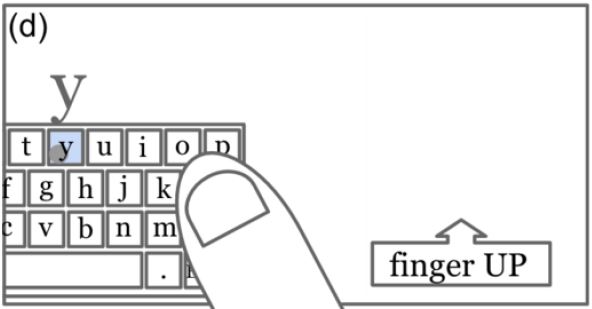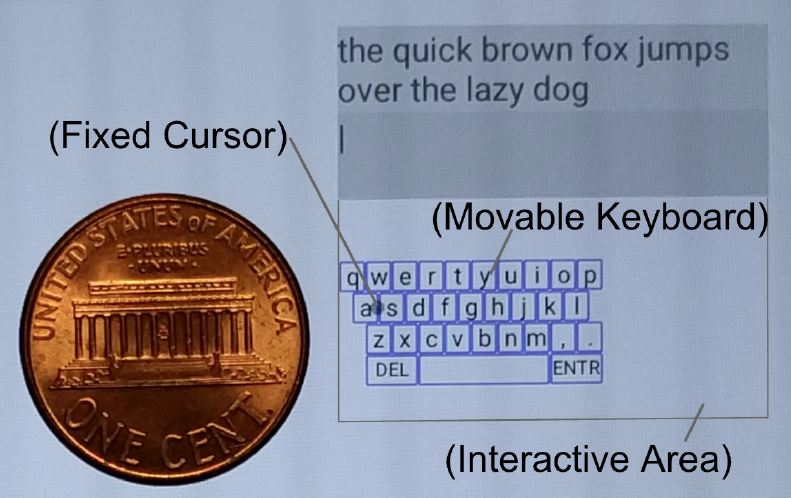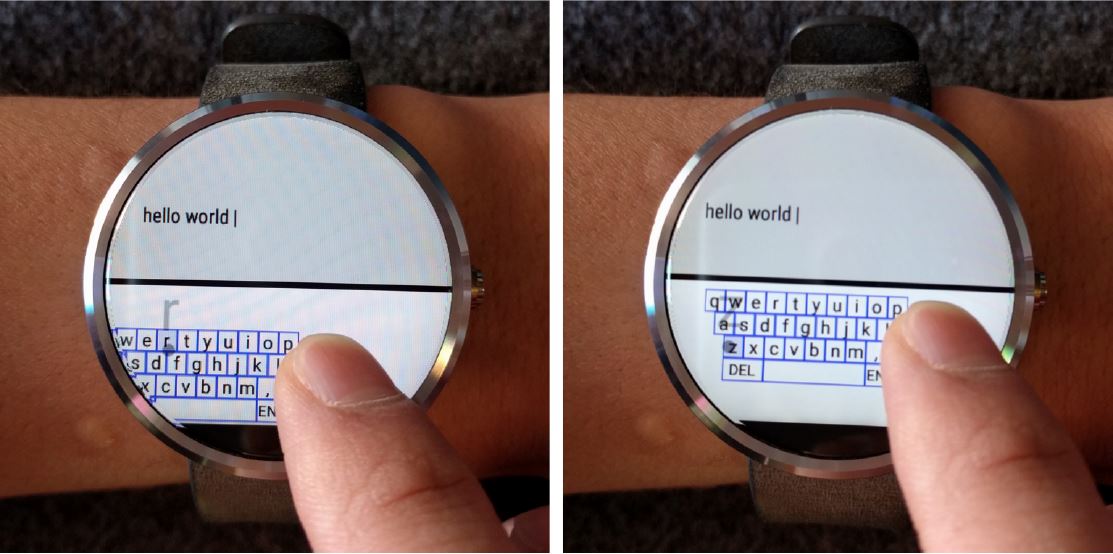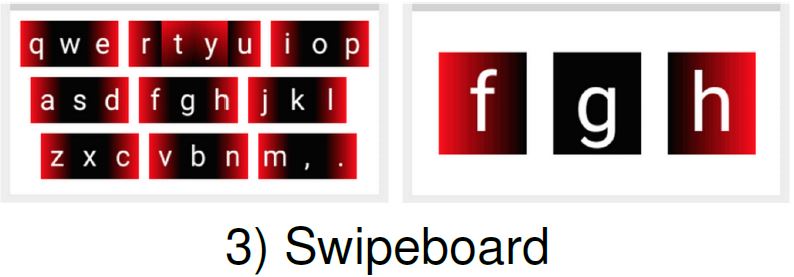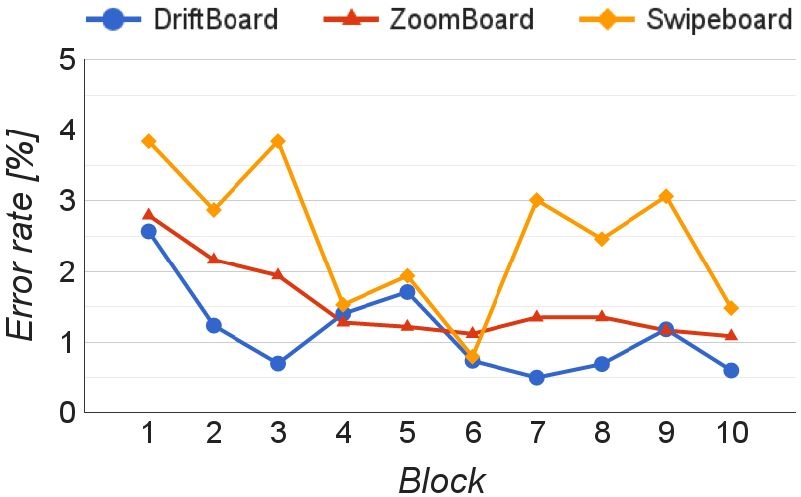Shibata, T., Afergan, D., Kong, D., Yuksel, B. F., MacKenzie, I. S., & Jacob, R. J. K. (2016). Text entry for ultra-small touchscreens using a fixed cursor and movable keyboard. Extended Abstracts of the ACM SIGCHI Conference on Human Factors in Computing Systems - CHI 2016, pp. 3770-3773. New York: ACM. doi: http://dx.doi.org/10.1145/2851581.2890230 [PDF] [video]
Abstract Text Entry for Ultra-Small Touchscreens Using a Fixed Cursor and Movable Keyboard
Tomoki Shibata1, Daniel Afergan2, Danielle Kong3, Beste F. Yuksel4, I. Scott MacKenzie5, and Robert J. K. Jacob6
1Tufts University Medford, MA, USA
tshibata@cs.tufts.edu2Tufts University
Google Inc. Mountain View, CA, USA
afergan@google.com3Tufts University Medford, MA, USA
danielle.kong@tufts.edu4Tufts University Medford, MA, USA
byukse01@cs.tufts.edu5York University Toronto, ON, Canada
mack@cse.yorku.ca6Tufts University Medford, MA, USA
jacob@cs.tufts.edu
Emerging ultra-small wearables like smartwatches pose a design challenge for touch-based text entry, due to the "fat finger" problem, wherein users struggle to select elements much smaller than their fingers. In order to address the challenge, we introduce DriftBoard, a panning-based text entry technique in which the user types by navigating the movable QWERTY keyboard with respect to the fixed cursor point. In this paper, we describe interactions on the proposed typing system, and report a preliminary result of our user study on a watch-size touchscreen with a text copy task comparing DriftBoard to two published ultra-small keyboards, ZoomBoard (tapping-based) and Swipeboard (swiping-based). Within the user study, DriftBoard performed comparably (no significant difference) to ZoomBoard in the major metrics of text entry speed and error rate, and outperformed Swipeboard, which suggests that the proposed panning-based typing is another promising input form for text entry on ultra-small touchscreens.Author Keywords
Text entry; ultra-small touchscreens; fat finger problem; fixed cursor and movable keyboardACM Classification Keywords
H.5.2 [User Interfaces]: Input devices and strategies, Interaction styles
Introduction
User input on ultra-small wearables is far more limited than output. For example, smartwatches offer instant access to notification messages, but responsive interactions to them still pose a challenge. Notably, text entry with a conventional software keyboard on a smartwatch will suffer due to the fat finger problem [7], wherein a finger of low spatial resolution will not be able to precisely point the tiny character keys.
Related Work
Not limited to text entry, but input formats for wearables have been actively studied. For example, exploring input spaces on skin, Skinput [4], or on the back side of a device, Back-of-device [1], carrying a sharp stylus on a finger tip, NanoStylus [8], and so on.
For text entry, several leading approaches that manipulate the keyboard display or introduce new gesture sequences have shown promise against the hurdle. For instance, ZoomBoard [6] employs a tapping-based approach where tap actions at certain times zoom in the keyboard display; therefore, the desired key becomes large enough to touch. Swipeboard [3] employs a swiping-based approach where each character is associated with a unique sequence of swiping actions; therefore, a user does not need to hit an exact location on the screen.
Yet, not all available touch-based interactions have been examined as input forms of text entry.
DriftBoard Interaction
Our goal is 1) to design a touch-based input technique which overcomes the fat finger problem, and 2) to validate its potential for practical use with the hope of facilitating text entry on ultra-small touchscreens.
To accomplish this, we begin with proposing DriftBoard, a panning-based text entry technique using a fixed cursor point and movable QWERTY keyboard. To type with DriftBoard, the user performs a panning action: dragging the movable QWERTY keyboard towards the fixed cursor point, and then releasing the finger from the touchscreen, which types the character that is currently underneath the fixed cursor. (If no character key is acquired by the fixed cursor at the time of the finger release, no character is typed.)
From a technical view, a panning action can be described with the three primitive finger events: finger DOWN, MOVE and UP. Within one panning action, the finger DOWN event initiates panning; a series of finger MOVE events continuously translate the location of the movable keyboard, and then a finger UP event completes the panning action and finally types the character acquired by the fixed cursor.
Figure 1 illustrates the interaction on DriftBoard with the three key components (the fixed cursor, movable keyboard, and interactive area) and the user's finger events forming a panning action. Figure 2 shows its physical size for a user study, and Figure 4 demonstrates a user typing with DriftBoard on an Android smartwatch with a round display.
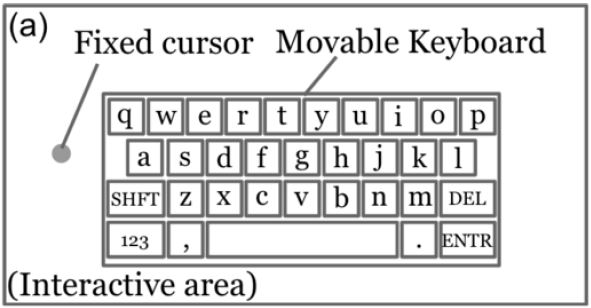
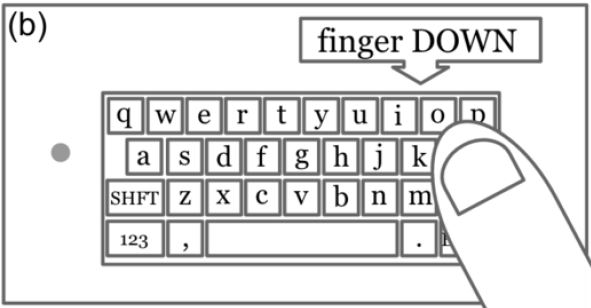
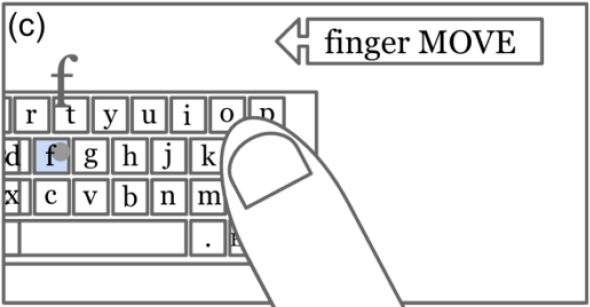
Figure 1: (a) DriftBoard basics. To type, the user (b) places a finger down on the interactive area, (c) moves the finger to navigate the movable keyboard towards the fixed cursor, and then (d) releases the finger from the interactive area, wherein "y" is typed in this case. Note that the bound of the movable keyboard can go outside of the interactive area, and that key highlighting and enlargement are provided for the character underneath the fixed cursor.
Figure 2: DriftBoard prototype on an Android touchscreen device and a U.S. one cent coin next to it as a reference scale. In the user study, participants were asked to type the sentence appearing on top.
Figure 4: DriftBoard prototype in action on a smartwatch with a round display (Motorola Moto 360). Left, the fixed cursor is on top of "r". Right, the location of the fixed cursor remains the same, but it acquires "z" as the result of keyboard movement. Note that in the DriftBoard concept, the size of the movable keyboard is not necessarily the same as the device' frame size. Note also that DriftBoard is applicable to more shapes than just a rectangle.
This pan technique differs in concept from conventional tap input techniques, in which the keyboard (target) remains stationary and the user navigates a cursor/finger (acquisition point) – here, the user navigates the keyboard (target) and the cursor (acquisition point) remains stationary.
Because a panning action can be initiated and completed at any part of the interactive touch area, regardless of the finger being on the keyboard or not, and the middle part of a panning allows the user to refine the keyboard location with respect to the fixed cursor, we believe our panning-based typing is an efficient means to address the fat finger problem.
Method
In order to investigate the potential of panning-based typing, we conducted a controlled user study with a text copy task utilizing DriftBoard (panning-based) on a smartwatch-size touchscreen (the interactive area is 28 × 14 mm, roughly half of the 1.6 inch diameter screen), as well as the two published ultra-small keyboards, Zoom-Board [6] (tapping-based) and Swipeboard [3] (swiping-based), replicated on the screen of the same size.
Participants
We used 10 participants (5 females) aged between 19 and 33 (Mean 22.8, SD 4.2). All were right handed, native English speakers or bilingual from birth, and had normal or corrected-to-normal vision. All were paid 10 U.S. dollars per hour for their participation, in addition to a performance bonus of 5 U.S. dollars.
Apparatus
All three input techniques were implemented as Android Applications. We used a tablet, Nexus 7 (2013), and covered up the unused surface area to offer the feeling of a watch size. The device was placed on a table while participants performed the task. Figure 3 presents the appearance of each input technique on the touchscreen.
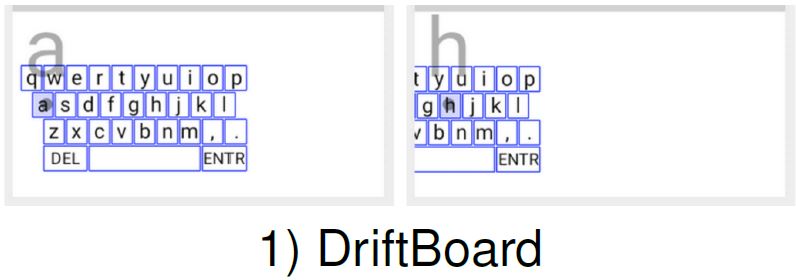
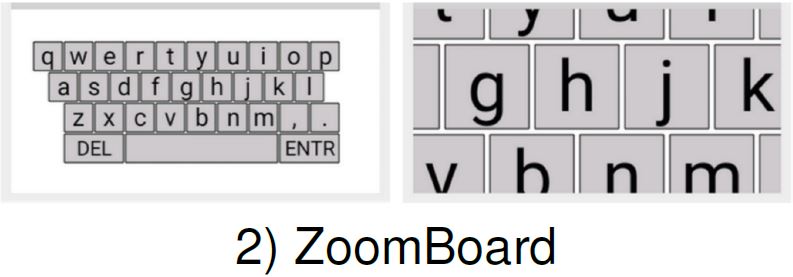
Figure 3: Appearances on the touchscreen for the user study. 1-Left) The fixed cursor of DriftBoard is acquiring "a", and 1-Right) is acquiring "h". 2-Left) The initial state of ZoomBoard, and 2-Right) a zoomed state by a tap near "h". 3-Left) The initial state of Swipeboard showing all of the character blocks, and 3-Right) the state showing the "fgh" block.
Procedure
The experiment was composed of 2 sessions (one per a day) for each participant with 3 input techniques per session, 5 blocks per input technique and 5 phrases per block. All phrases (lowercase only including space and no punctuation) were randomly picked from MacKenzie and Soukoreff's phrase set [5]. The participants were instructed 1) to use the index finger of the right hand 2) to memorize phrase (although the presented phrase does not disappear), 3) to correct a typo only when they realized it immediately after they made one, but ignore it if they already made progress on transcribing, and finally 4) to type as quickly and accurately as possible. In the first session, before experiencing each input technique, the participants watched the experimenter enter a few characters with verbal instructions. They were then asked to begin their trial blocks without any practice. In the second session, before starting each input technique, the participants were asked to type "hello world" to refresh their past experiences.Design
A within-subjects design with two independent variables: 3 input techniques and 10 trial blocks (to capture participants' improvements on typing). For the preliminary analysis, the dependent variables were text entry speed measured as words per minute (wpm) and error rate (%).To offset learning effects across the input techniques, each of all 6 possible orders of the 3 input techniques was assigned to one or two participants. Text entry speed and error rate were calculated by the methods described by Castellucci and MacKenzie [2]. Entry time was measured from the first to the last finger event on the interactive area, except for typing the ENTER key, which was used to indicate the completion of transcribing a phrase.
Replication notes: (ZoomBoard): Swipe to type a space and swipe to delete functionalists [6] were not implemented. The scaling factor for zoom-in was set to about ×3 [6]. (Swipeboard): The ENTER key was assigned to a double swiping down action. (ZoomBoard and Swipeboard): "2-second timeout" [3] was implemented. (DriftBorad): The location of the movable keyboard was reset to one, shown in Figure 2, every time a new phrase appears.
Results
We here report a preliminary analysis on 1,455 phrases out of the collected 1,500 total by excluding 7 erroneous data due to hardware issues, and 38 outliers, which appeared as error rates of more than 50% or efficiency (ratio of actual and optimal keystrokes per character) of less than 50%.
Figure 5 shows averaged performances of the text copy task. With about one hour of experience (at the 10th block), DriftBoard achieved a text entry speed of 9.74 wpm and an error rate of 0.6%. On entry speed, the ANOVA indicates significant effects of input method (F2,18 = 30.127, p < .0001), block (F9,81 = 36.617, p < .0001), and interaction (F18,162 = 1.746, p < .05). Post-hoc comparisons with Fisher LSD test on input method reveal no significant difference involving ZoomBoard, and significant differences between Swipeboard and DriftBoard. On error rate, the ANOVA indicates a significant effect of input method (F2,18 = 5.553, p < .05), and no significant effects of block (F9,81 = 1.799, p > .05) or (F18,162 = .760, ns). Post-hoc comparisons with the Fisher LSD test on input method reveal no significant difference involving ZoomBoard and significant differences between Swipeboard and DriftBoard.
(a) (b)
Figure 5: Text entry performance (a) entry speed and (b) error rate.
Conclusion
In this paper, we introduced a panning-based text entry mechanism, using a fixed cursor and movable QWERTY keyboard, to overcome the fat finger problem for text entry on ultra-small touchscreens. We demonstrated the potential of the panning-based approach compared with a tapping-based and swiping-based approach by replicating two published systems, ZoomBoard and Swipeboard. With the preliminary but promising result of the analysis, we believe the panning-based typing mechanism is a highly viable alternative for touch-based text entry on ultra-small touchscreens.
We will perform a full analysis on the collected data and report it in the near future.
Acknowledgments
We thank Ronna ten Brink, Remco Chang from Tufts University and NSF (IIS-1218170 and IIS-1065154) for support.
References
| [1] | Patrick Baudisch and Gerry Chu. 2009. Back-of-device Interaction
Allows Creating Very Small Touch Devices. In Proc. CHI 2009. 1923-1932.
https://doi.org/10.1145/1518701.1518995
|
| [2] | Steven J. Castellucci and I. Scott MacKenzie. 2011.
Gathering Text Entry Metrics on Android Devices. In
Proc. CHI EA 2011. 1507-1512.
https://doi.org/10.1145/1979742.1979799
|
| [3] | Xiang 'Anthony' Chen, Tovi Grossman, and George Fitzmaurice. 2014.
Swipeboard: A Text Entry Technique for Ultra-small Interfaces That
Supports Novice to Expert Transitions. In Proc. UIST 2014. 615-620.
https://doi.org/10.1145/2642918.2647354
|
| [4] | Chris Harrison, Desney Tan, and Dan Morris. 2011.
Skinput: Appropriating the Skin As an Interactive Canvas. Commun. ACM
54, 8 (Aug. 2011), 111-118.
https://doi.org/10.1145/1978542.1978564
|
| [5] | I. Scott MacKenzie and R. William Soukoreff. 2003.
Phrase Sets for Evaluating Text Entry Techniques. In
Proc. CHI EA 2003. 754-755.
https://doi.org/10.1145/765891.765971
|
| [6] | Stephen Oney, Chris Harrison, Amy Ogan, and Jason Wiese. 2013.
ZoomBoard: A Diminutive Qwerty Soft Keyboard Using Iterative Zooming for
Ultra-small Devices. In Proc. CHI 2013. 2799-2802.
https://doi.org/10.1145/2470654.2481387
|
| [7] | Katie A. Siek, Yvonne Rogers, and Kay H. Connelly.
2005. Fat Finger Worries: How Older and Younger Users Physically
Interact with PDAs. In Proc. INTERACT 2005. 267-280.
https://doi.org/10.1007/11555261_24
|
| [8] | Haijun Xia, Tovi Grossman, and George Fitzmaurice. 2015. NanoStylus: Enhancing Input on Ultra-Small Displays with a Finger-Mounted Stylus. In Proc. UIST 2015. 447-456. https://doi.org/10.1145/2807442.2807500 |
